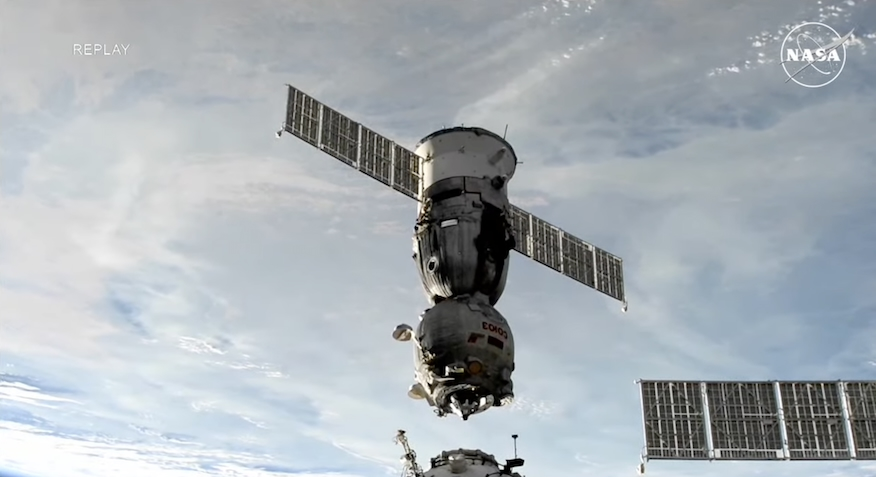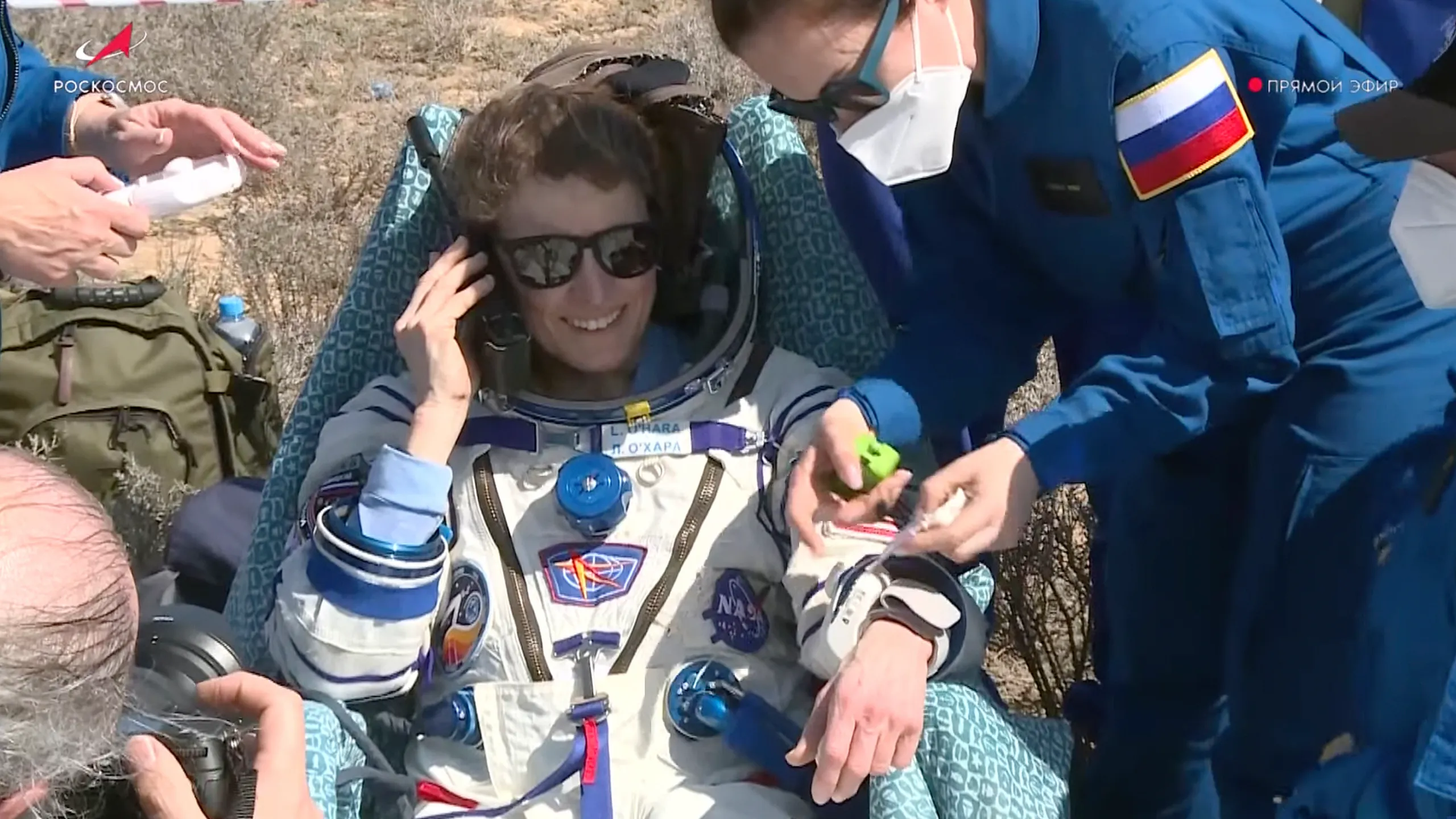Soyuz, the reliable spacecraft known for ferrying astronauts to and from space, has once again successfully returned a crew from the International Space Station (ISS). On Monday, a Russian Soyuz capsule landed on the Kazakh steppe, bringing home two Russian cosmonauts and a U.S. astronaut after an extended stay aboard the ISS.
The spacecraft completed its mission by safely delivering cosmonauts Oleg Kononenko, Nikolai Chub, and NASA astronaut Tracy Dyson back to Earth. This latest mission adds another achievement to the long history of Soyuz missions, which continue to play a crucial role in maintaining human presence in space.
The spacecraft, a symbol of Russia’s space capabilities, has been instrumental in the ISS program since its inception. Over the years, Soyuz has safely transported hundreds of astronauts, cosmonauts, and space tourists to the space station and back.
Its latest mission brought Oleg Kononenko and Nikolai Chub back to Earth after a record-breaking stay of 374 days aboard the ISS. For American astronaut Tracy Dyson, the return marked the conclusion of a six-month mission. spacecraft , as always, performed flawlessly, ensuring the astronauts’ safe return after their long-duration missions in space.
Record-Breaking Stay on the International Space Station
The return of the Soyuz capsule marked the end of a historic mission for Russian cosmonauts Oleg Kononenko and Nikolai Chub. Their 374-day stay aboard the ISS set a new record for the longest continuous time spent on the station by Russian astronauts.
Read : NASA’s SpaceX Crew-9 Duo Lands at Kennedy Space Center: Gears Up to Rescue Sunita Williams from ISS
This remarkable achievement is a testament to the dedication and resilience of both men, as well as the reliability of the spacecraft. Oleg Kononenko, in particular, is no stranger to long-duration missions, having accumulated more than 1,000 days in space over the course of his career, making him one of the most experienced space travelers in history.
Soyuz has long been the workhorse of human spaceflight, with its design dating back to the 1960s. Despite its age, the spacecraft remains one of the most reliable and frequently used vehicles for ferrying astronauts to and from the ISS.
The Soyuz MS-25 spacecraft, which brought Kononenko, Chub, and Dyson back to Earth, is a modernized version of the original spacecraft design. It boasts improved safety features, upgraded avionics, and greater efficiency, ensuring that it remains a vital part of the ISS program.

While Oleg Kononenko and Nikolai Chub’s year-long mission set a record, NASA astronaut Tracy Dyson’s stay aboard the ISS lasted 184 days, a standard duration for crew members participating in long-term expeditions.
The combination of American and Russian crew members aboard the spacecraft capsule underscores the ongoing international collaboration in space exploration, even amid geopolitical tensions.
Soyuz continues to serve as a crucial bridge between nations, enabling astronauts from around the world to work together in the pursuit of scientific advancement and exploration.
The Role of Soyuz in Space Exploration
Soyuz has a rich history that dates back to the early days of the space race. Originally developed by the Soviet Union, the spacecraft was designed to carry cosmonauts into orbit and, eventually, to the Moon. Although the Soviet lunar program was never realized, spacecraft has continued to evolve and adapt to new challenges.
Today, Soyuz remains a vital part of the ISS program, serving as both a transport vehicle and a lifeboat for astronauts stationed aboard the ISS. Its longevity and reliability have made it an essential tool in the continued human presence in space.
Soyuz’s role in space exploration has expanded significantly over the years. In addition to its missions to the ISS, Soyuz has been used for a variety of other purposes, including satellite launches, space tourism, and scientific research.
Soyuz spacecraft have been used to launch astronauts from various countries, including Europe, Japan, and the United States, as part of international agreements with Roscosmos, the Russian space agency. This international cooperation has been a hallmark of the ISS program, and spacecraft has played a central role in making it possible.
Despite the development of new spacecraft like SpaceX’s Crew Dragon and Boeing’s Starliner, spacecraft remains a critical component of human spaceflight. Its proven track record of safety and reliability has ensured that it continues to be used for missions to the ISS.

Even with the introduction of new spacecraft, Soyuz is expected to remain in service for many years to come, providing a reliable backup for other vehicles and serving as a key part of Russia’s space program.
The Future of Human Spaceflight
As space exploration enters a new era, with private companies and new government programs emerging, Soyuz remains an integral part of the human spaceflight landscape. While the recent return of the spacecraft capsule from the ISS marks the end of one mission, it also serves as a reminder of the spacecraft’s ongoing importance.
Soyuz missions are scheduled regularly, with crews rotating in and out of the ISS to conduct research, perform maintenance, and ensure the continued operation of the space station.
Soyuz’s role in future missions to the ISS is secure, but the spacecraft may also play a part in other ventures. As humanity looks to explore beyond low Earth orbit, spacecraft could be adapted for missions to the Moon or even Mars.
Although newer spacecraft are being developed for deep space exploration, Soyuz’s reliability and cost-effectiveness make it a valuable asset for a wide range of missions. As the space industry evolves, spacecraft will likely continue to be a workhorse for both Roscosmos and its international partners.
In addition to its role in human spaceflight, Soyuz has also been used for launching cargo to the ISS. The Progress spacecraft, a derivative of the Soyuz design, has been used to deliver supplies and equipment to the space station for decades.
Like its manned counterpart, Progress is known for its reliability and efficiency, making it an essential part of the ISS resupply program. The continued use of Soyuz and Progress for cargo and crew transport ensures that the ISS remains a hub for scientific research and international collaboration.
The Importance of International Collaboration
The recent Soyuz mission, which carried both Russian cosmonauts and a U.S. astronaut, highlights the importance of international cooperation in space. Despite political tensions between Russia and the West, the ISS program has remained a beacon of collaboration, with astronauts from various countries working together to achieve common goals.

Soyuz, as one of the primary vehicles for transporting astronauts to and from the ISS, plays a critical role in maintaining this partnership.
The return of the spacecraft capsule also serves as a reminder of the shared challenges and opportunities in space exploration. The ISS is not just a laboratory for scientific research; it is also a symbol of what humanity can achieve when nations work together.
As new space programs emerge and private companies enter the field, the importance of collaboration will only grow. Soyuz, with its decades of experience and proven track record, will continue to be a key part of this collaborative effort.
LIVE: Astronaut Tracy Dyson and her crewmates return to Earth aboard a Soyuz spacecraft. Watch as it re-enters Earth’s atmosphere and lands assisted by parachute, with an expected touchdown time of 7:59am ET (1159 UTC). https://t.co/7wNeFJcD3C
— NASA (@NASA) September 23, 2024
Soyuz missions are also a testament to the resilience of human spaceflight. Over the years, Soyuz has faced numerous challenges, including technical issues, political upheavals, and economic difficulties.
Yet, it has remained a reliable and essential part of space exploration. The recent mission, which saw the safe return of astronauts after a record-breaking stay aboard the ISS, is a testament to the durability and effectiveness of the Soyuz program.
In conclusion, Soyuz has once again proven its value by safely bringing three astronauts back from the International Space Station. The spacecraft’s role in human spaceflight is undeniable, and its recent mission only adds to its legacy.
With the return of Oleg Kononenko, Nikolai Chub, and Tracy Dyson, Soyuz has once again demonstrated its reliability and importance in maintaining the ISS program.
As humanity looks to the future of space exploration, spacecraft will undoubtedly continue to play a key role in ensuring the success of missions to the ISS and beyond.
let’s enjoy few years on earth with peace and happiness….✍🏼🙏

